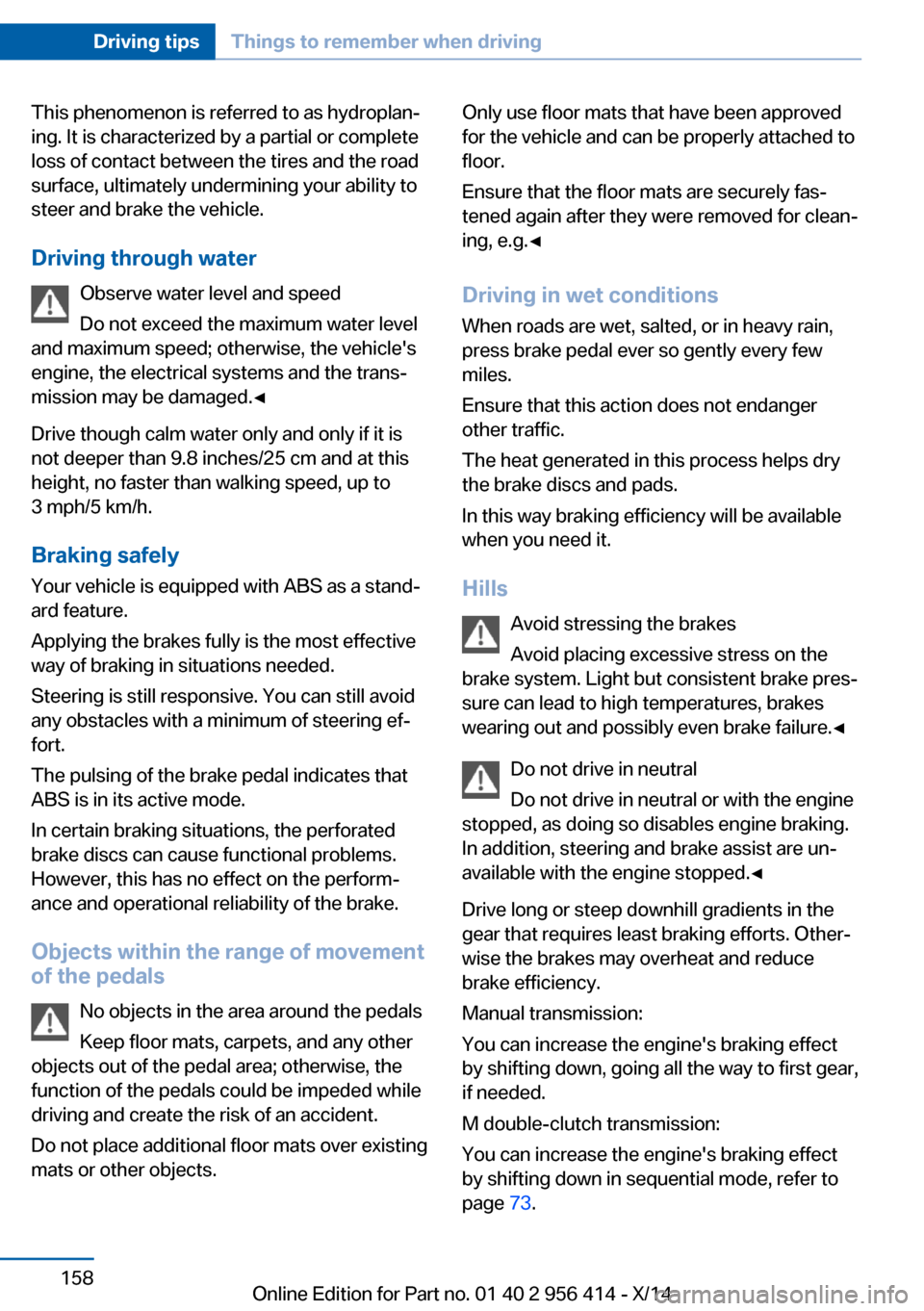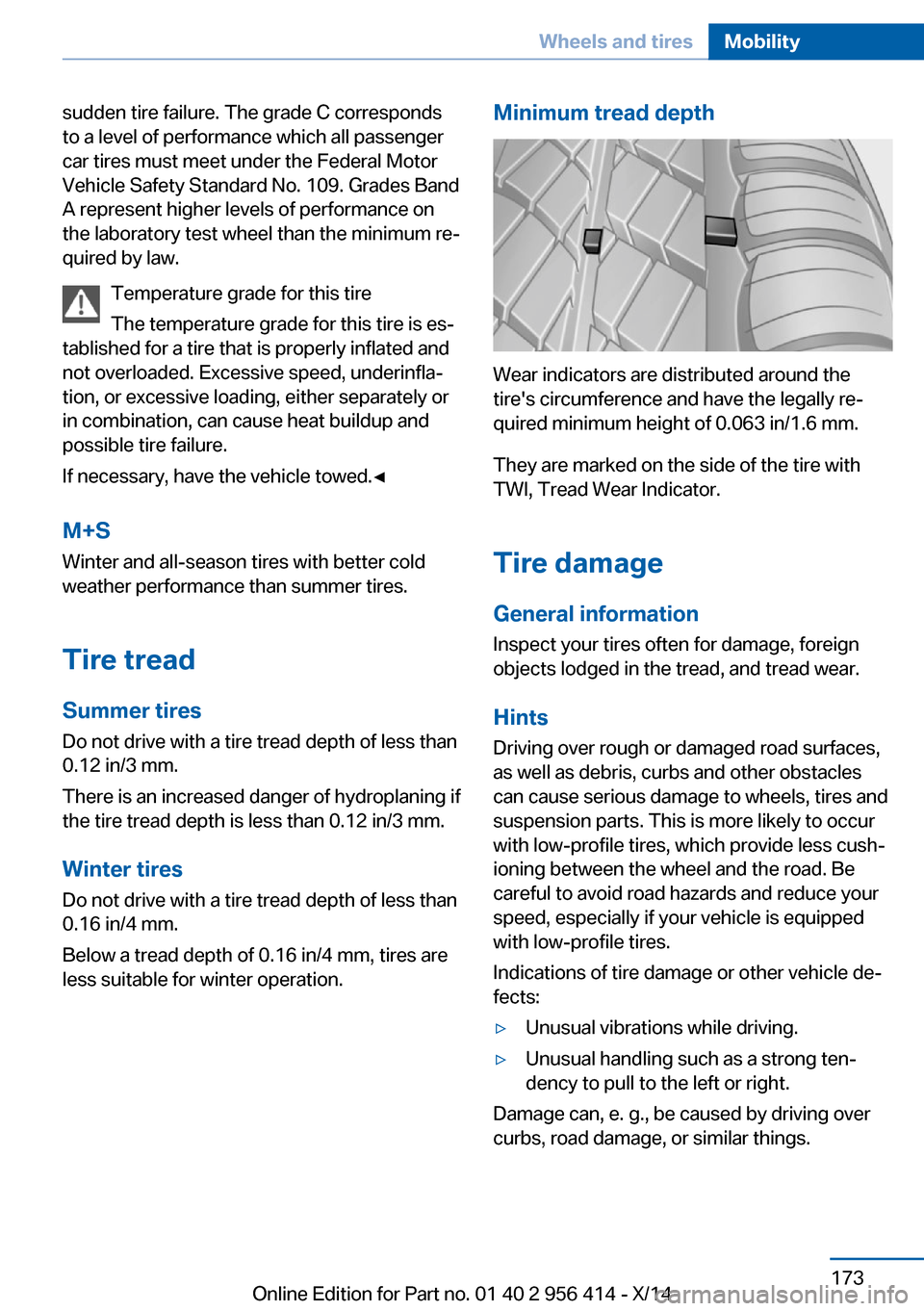2014 BMW M6 COUPE height
[x] Cancel search: heightPage 162 of 222

This phenomenon is referred to as hydroplan‐
ing. It is characterized by a partial or complete
loss of contact between the tires and the road
surface, ultimately undermining your ability to
steer and brake the vehicle.
Driving through water Observe water level and speed
Do not exceed the maximum water level
and maximum speed; otherwise, the vehicle's
engine, the electrical systems and the trans‐
mission may be damaged.◀
Drive though calm water only and only if it is
not deeper than 9.8 inches/25 cm and at this
height, no faster than walking speed, up to
3 mph/5 km/h.
Braking safely
Your vehicle is equipped with ABS as a stand‐
ard feature.
Applying the brakes fully is the most effective
way of braking in situations needed.
Steering is still responsive. You can still avoid
any obstacles with a minimum of steering ef‐
fort.
The pulsing of the brake pedal indicates that
ABS is in its active mode.
In certain braking situations, the perforated
brake discs can cause functional problems.
However, this has no effect on the perform‐
ance and operational reliability of the brake.
Objects within the range of movement
of the pedals
No objects in the area around the pedals
Keep floor mats, carpets, and any other
objects out of the pedal area; otherwise, the
function of the pedals could be impeded while driving and create the risk of an accident.
Do not place additional floor mats over existing
mats or other objects.Only use floor mats that have been approved
for the vehicle and can be properly attached to
floor.
Ensure that the floor mats are securely fas‐
tened again after they were removed for clean‐
ing, e.g.◀
Driving in wet conditions When roads are wet, salted, or in heavy rain,
press brake pedal ever so gently every few
miles.
Ensure that this action does not endanger other traffic.
The heat generated in this process helps dry
the brake discs and pads.
In this way braking efficiency will be available
when you need it.
Hills Avoid stressing the brakes
Avoid placing excessive stress on the
brake system. Light but consistent brake pres‐
sure can lead to high temperatures, brakes
wearing out and possibly even brake failure.◀
Do not drive in neutral
Do not drive in neutral or with the engine
stopped, as doing so disables engine braking.
In addition, steering and brake assist are un‐
available with the engine stopped.◀
Drive long or steep downhill gradients in the
gear that requires least braking efforts. Other‐
wise the brakes may overheat and reduce
brake efficiency.
Manual transmission:
You can increase the engine's braking effect
by shifting down, going all the way to first gear,
if needed.
M double-clutch transmission:
You can increase the engine's braking effect
by shifting down in sequential mode, refer to
page 73.Seite 158Driving tipsThings to remember when driving158
Online Edition for Part no. 01 40 2 956 414 - X/14
Page 177 of 222

sudden tire failure. The grade C corresponds
to a level of performance which all passenger
car tires must meet under the Federal Motor
Vehicle Safety Standard No. 109. Grades Band
A represent higher levels of performance on
the laboratory test wheel than the minimum re‐
quired by law.
Temperature grade for this tire
The temperature grade for this tire is es‐
tablished for a tire that is properly inflated and
not overloaded. Excessive speed, underinfla‐
tion, or excessive loading, either separately or
in combination, can cause heat buildup and
possible tire failure.
If necessary, have the vehicle towed.◀
M+S
Winter and all-season tires with better cold
weather performance than summer tires.
Tire tread Summer tires Do not drive with a tire tread depth of less than
0.12 in/3 mm.
There is an increased danger of hydroplaning if
the tire tread depth is less than 0.12 in/3 mm.
Winter tires
Do not drive with a tire tread depth of less than
0.16 in/4 mm.
Below a tread depth of 0.16 in/4 mm, tires are
less suitable for winter operation.Minimum tread depth
Wear indicators are distributed around the
tire's circumference and have the legally re‐
quired minimum height of 0.063 in/1.6 mm.
They are marked on the side of the tire with
TWI, Tread Wear Indicator.
Tire damage
General information
Inspect your tires often for damage, foreign
objects lodged in the tread, and tread wear.
Hints
Driving over rough or damaged road surfaces,
as well as debris, curbs and other obstacles
can cause serious damage to wheels, tires and
suspension parts. This is more likely to occur
with low-profile tires, which provide less cush‐
ioning between the wheel and the road. Be
careful to avoid road hazards and reduce your
speed, especially if your vehicle is equipped
with low-profile tires.
Indications of tire damage or other vehicle de‐
fects:
▷Unusual vibrations while driving.▷Unusual handling such as a strong ten‐
dency to pull to the left or right.
Damage can, e. g., be caused by driving over
curbs, road damage, or similar things.
Seite 173Wheels and tiresMobility173
Online Edition for Part no. 01 40 2 956 414 - X/14
Page 184 of 222

Never reach into the engine compart‐
ment
Never reach into spaces or gaps in the engine
compartment; otherwise, there is a risk of in‐
jury, e.g., from rotating or hot parts.◀
Danger of injury when the hood is open
There is a danger of injury from protrud‐
ing parts when the hood is open.◀1.Pull the lever.2.Press the release handle and open the
hood.3.Be careful of protruding parts on the hood.Closing the hood
Hood open when driving
If you see any signs that the hood is not
completely closed while driving, pull over im‐
mediately and close it securely.◀
Danger of jamming
Make sure that the closing path of the
hood is clear; otherwise, injuries may result.◀
Let the hood drop from a height of approx. 16
in/40 cm and push down on it to lock it fully.
The hood must audibly engage on both sides.
Seite 180MobilityEngine compartment180
Online Edition for Part no. 01 40 2 956 414 - X/14
Page 210 of 222

Technical dataVehicle features and options
This chapter describes all standard, country-
specific and optional features offered with the
series. It also describes features that are notnecessarily available in your car, e. g., due to
the selected options or country versions. This
also applies to safety-related functions and
systems.
Note
The technical data and specifications in this
Owner's Manual are used as guidance values.
The vehicle-specific data can deviate from this,
for example, due to the selected special equip‐
ment, country version or country-specific
measurement method. Detailed values can befound in the approval documents, on informa‐
tion signs on the vehicle or can be obtained
from the service center.
The information in the vehicle documents al‐
ways has priority.
Dimensions
Note
The dimensions can vary depending on the
model version, equipment or country-specific
measurement method.
The specified heights do not take into account
attached parts, for example, a roof antenna,roof racks or spoiler. The heights can deviate,
for example, due to the selected special equip‐
ment, tires, load and chassis version. BMW M6 CoupeWidth with mirrorsinches/mm82.9/2,106Width without mirrorsinches/mm74.8/1,899Heightinches/mm54.1/1,374Lengthinches/mm193.0/4,903Wheelbaseinches/mm112.2/2,851Smallest turning radius diam.ft/m39.7/12.1
Weights
The values preceding the slash apply to vehi‐
cles with manual transmission; the values fol‐lowing the slash apply to vehicles with M dou‐
ble-clutch transmission.Seite 206ReferenceTechnical data206
Online Edition for Part no. 01 40 2 956 414 - X/14
Page 215 of 222

External temperature dis‐play 83
External temperature warn‐ ing 83
Eyes for securing cargo 161
F
Failure message, see Check Control 79
False alarm, refer to Uninten‐ tional alarm 44
Fan, refer to Air flow 139
Filler neck for engine oil 182
Fine wood, care 201
First aid kit 194
Fitting for towing, see tow fit‐ ting 197
Flat tire, changing wheels 190
Flat Tire Monitor FTM 106
Flat tire, repairing 175
Flat tire, Tire Pressure Moni‐ tor TPM 103
Flat tire, warning lamp 104, 106
Flooding 158
Floor carpet, care 202
Floor mats, care 202
Fold-out position, wiper 71
Foot brake 158
For the roofliner, refer to All around the interior rearview
mirror 17
Front airbags 100
Front center armrest 149
Front-end collision warning with City Braking func‐
tion 108
Front lights 187
front-seat passenger airbags, automatic deactivation 102
Front-seat passenger airbags, indicator lamp 102
Front seats 48 Front turn signals, refer to
Light-emitting diodes,
LEDs 188
FTM Flat Tire Monitor 106
Fuel 168
Fuel consumption, current 84
Fuel consumption, refer to Average fuel consump‐
tion 89
Fuel filler flap 166
Fuel gauge 82
Fuel lid 166
Fuel quality 168
Fuel recommendation 168
Fuel, tank capacity 207
Fuse 191
G
Garage door opener, refer to Universal Integrated Remote
Control 142
Gasoline 168
Gear change 74
Gear shift indicator 87
General driving notes 157
Glare shield 144
Glass sunroof, powered with tilt function 46
Glove compartment 148
Gross vehicle weight, ap‐ proved 206
Ground clearance 159
H
Handbrake, refer to Parking brake 67
Hand-held transmitter, alter‐ nating code 143
Hazard warning flashers 193
Head airbags 100
Headlight control, auto‐ matic 96
Headlight courtesy delay fea‐ ture 95 Headlight courtesy delay fea‐
ture via remote control 38
Headlight flasher 69
Headlight glass 188
Headlights 187
Headlights, care 200
Headlight washer system 69
Head restraints 48
Head restraints, front 52
Head-up Display 92
Head-up Display, care 202
Head-up display, M view 93
Head-up display, standard view 93
Heavy cargo, stowing 161
Height, seats 48
Height, vehicle 206
High-beam Assistant 97
High beams 69
High beams/low beams, refer to High-beam Assistant 97
Higher speed range 159
Hills 158
Hill start assistant, refer to Drive-off assistant 122
Hints 6
Holder for beverages 150
Hood 179
Horn 14
Hotel function, trunk lid 40
Hot exhaust system 157
HUD Head-up Display 92
Hydroplaning 157
I Ice warning, see External temperature warning 83
Icy roads, see External tem‐ perature warning 83
Identification marks, tires 171
Identification number, see ve‐ hicle identification num‐
ber 9
iDrive 18 Seite 211Everything from A to ZReference211
Online Edition for Part no. 01 40 2 956 414 - X/14